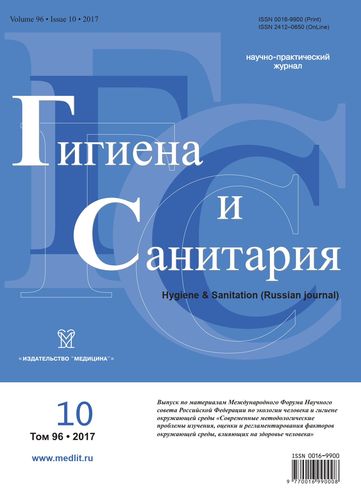The formation of the optimal light environment is the actual hygienic problem
- Authors: Kaptsov V.A.1, Deynego V.N.2
-
Affiliations:
- All-Russian Research Institute of Railway Hygiene of the Federal Service for the Oversight of Consumer Protection and Welfare
- ZAO Company “ELTAN”
- Issue: Vol 96, No 10 (2017)
- Pages: 933-940
- Section: PROBLEM-SOLVING ARTICLES
- Published: 21.10.2020
- URL: https://ruspoj.com/0016-9900/article/view/640699
- DOI: https://doi.org/10.47470/0016-9900-2017-96-10-933-940
- ID: 640699
Cite item
Full Text
Abstract
The light environment with respect to time of the exposure is shown to affect the formation of myopia in the young generation in a number of countries that effectively implemented energy-saving lamps. There are both considered mechanisms of the negative impact of artificial light on the human eye and formed the requirements for an optimal light environment which will contribute to the reducing the risk of the development of myopia. The spectral composition of the light environment must be adequate spectrum of sunlight with color temperatures below 4000K, the light levels should be chosen by the principle for comfort lighting.
Keywords
About the authors
Valery A. Kaptsov
All-Russian Research Institute of Railway Hygiene of the Federal Service for the Oversight of Consumer Protection and Welfare
Author for correspondence.
Email: kapcovva39@mail.ru
ORCID iD: 0000-0002-3130-2592
MD, PhD, DSci., professor, member-correspondent of RAS, Deputy Director for scientific work of the All-Russian Research Institute of Railway Hygiene of the Federal Service for the Oversight of Consumer Protection and Welfare, Moscow, 125438, Russian Federation.
e-mail: kapcovva39@mail.ru
Russian FederationV. N. Deynego
ZAO Company “ELTAN”
Email: noemail@neicon.ru
Russian Federation
References
- Ellwein L. Personal Communication. Bethesda, MD: 1998.
- Khu T. Economic costs of visual impairment and disabled. Special report of the National Eye Institute (NPI) [Ekonomicheskie izderzhki narusheniya zreniya i invalidov. Spetsial’nyy doklad Natsional’nogo instituta glaza (YaEU)]. Betesda, MD; 1981. (in Russian)
- Zhuravleva E.V. Adaptive features of the visual analyzer for students of different ethnic groups in the learning process: Diss. Nizhniy Novgorod; 2011. (in Russian)
- Jung S.K., Lee J.H., Kakizaki H., Jee D. Prevalence of Myopia and its Association with Body Stature and Educational Level in 19-Year-Old Male Conscripts in Seoul, South Korea. Invest. Ophthalmol. Vis. Sci. 2012; 53(9): 5579–83.
- Deynego V.N., Kaptsov V.A., Balashevich L.I., Svetlova O.V., Makarov F.N., Guseva M.G., et al. Prevention of eye diseases in children and adolescents in classrooms with LED light sources of the first generation. Rossiyskaya detskaya oftal’mologiya. 2016; (2): 57–73. (in Russian)
- Svetlova O.V., Koshits I.N. Interaction of the main ways of outflow of the intraocular fluid with the mechanism of accommodation: Textbook [Vzaimodeystvie osnovnykh putey ottoka vnutriglaznoy zhidkosti s mekhanizmom akkomodatsii: Uchebnoe posobie]. St. Petersburg; 2002. (in Russian)
- Strasburger H., Bach M., Heinrich S. Blur Unblurred – A Mini-Tutorial (ECVP 2016). Available at: http://hans-strasburger.userweb.mwn.de/reprints_b.html
- Ravikumar A., Sarver E.J., Applegate R.A. Change in visual acuity is highly correlated with change in six image quality metrics independent of wavefront error and/or pupil diameter. J. Vis. 2012; 12(10): 11.
- Smith G. Angular diameter of defocus blur discs. Am. J. Optom. Physiol. Opt. 1982; 59(11): 885–9.
- Zak P.P. The Reasons for Limiting the Color Temperature of LED Lighting in Educational, Preschool and Medical Institutions [Osnovaniya ogranicheniya tsvetovoy temperatury svetodiodnogo osveshcheniya v obrazovatel’nykh, doshkol’nykh i lechebnykh uchrezhdeniyakh]. Moscow; 2015. (in Russian)
- Yur’eva S.L., Obrubov S.A., Ivanova A.O. A method of modeling axial myopia. Patent RF № 2541743; 2015. (in Russian)
- Obrubov S.A., Khamnagdaeva N.V., Semenova L.Yu., Poryadin G.V., Salmasi Zh.M. Experimental models of axial myopia: approaches to the study of development mechanisms. Rossiyskaya detskaya oftal’mologiya. 2015; (2): 58. (in Russian)
- Strauss O. Retinal Pigment Epithelium in Visual Function. Physiol. Rev. 2005; 85(3): 845–81.
- Kaptsov V.A., Deynego V.N. Q-law as a methodological basis of hygienic requirements for the light environment. Gigiena i sanitariya. 2017; 96(8): 747–751.
Supplementary files









